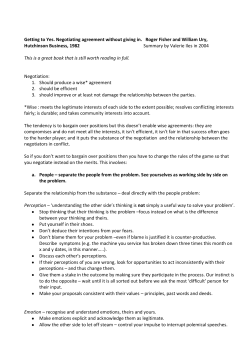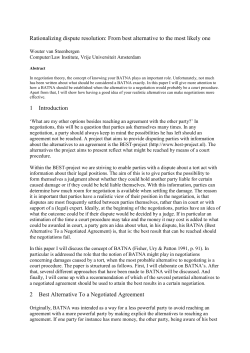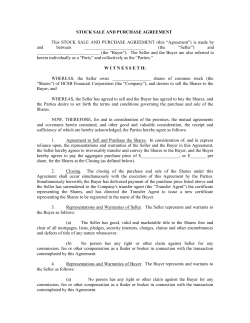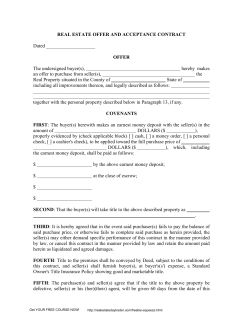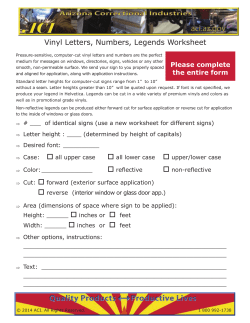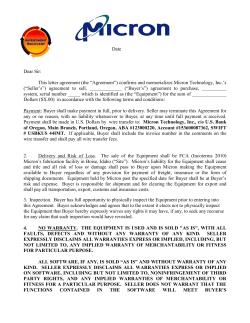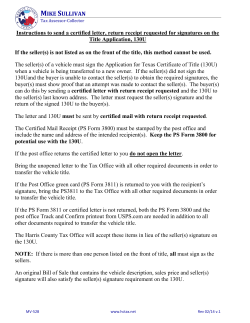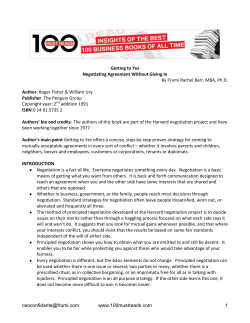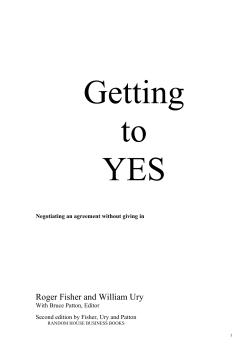
Document 39393
The Anderson School at UCLA POL 2000-10 Numbers 101: Bargaining and BATNA Copyright © 2000 by Richard P. Rumelt. Bargaining and negotiation are not only part of everyday life; they are a central part of business life. We bargain with parents, friends, teachers, spouses, employers, and so on. We negotiate where to spend the next winter vacation; we negotiate the salary and benefits we receive as employees. Companies negotiate contracts with one another. Giant corporations negotiate acquisitions where the stakes are billions of dollars. Nation states negotiate treaties; even war itself often ends with an agreement to negotiate the terms of the peace. Negotiation is not a science, but neither is it is not a total mystery. This note is a quick introduction to distributive negotiation. It covers the concepts of target points, alternatives, BATNA, reservation points, bargaining zone, and the bargaining process. The Bargaining Box Exhibit 1 The Bargaining Box Bargaining Box Buyer ($12.000 Reservation Point) Seller ($9,000 Peservation Point) 0 10,000 A Buyer and a Seller negotiate over the price of a used car. The buyer’s considered position is that she will pay no more than $12,000. The Seller’s considered position is that he will accept no less than $9,000. We call these constraints reservation points. They are not normally public knowledge, though each party should know their own reservation point. In common language, the reservation point is sometimes called the “walk away price.” Cost and Value Over Time POL 2000-09 2 Is it possible to reach an agreement? Exhibit 1 displays the two reservation points and the resultant bargaining box—the region of deals that satisfies both constraints. It seems that any outcome between $9,000 and $12,000 will satisfy both the Buyer’s and the Seller’s constraints. Therefore, it should be possible to arrive at an outcome that is beneficial to both. The price $10,000, for example, gives the Seller a surplus of $1,000 over his reservation point, and gives the Buyer a surplus of $2,000 over her reservation point. It is possible that a Buyer and a Seller have reservation points that make it impossible to reach an agreement. Exhibit 2 illustrates this situation. Here the Buyer will pay no more than $10,000 and the Seller will accept no less than $11,000. Given that these are the true reservation points, there is no deal acceptable to both. The negotiations may nevertheless occur, and drag on for a while. This can happen because each party may hide their true reservation point and each may believe that the other’s reservation point is lower or higher than it really is. Exhibit 2 Negotiated Agreement Not Possible Buyer ($10.000 Reservation Point) Seller ($11,000 Reservation Point) 0 10,000 Bargaining Given each party’s reservation point, bargaining is the process dividing up the surplus, if any. We call the kind of negotiation in the example being considered distributive because is concerns the distribution of the surplus (the size of the bargaining box) between (or among) the parties. In the case of the used car, the total surplus is $3,000 and the process of bargaining will result in is division between Buyer and Seller. If we assume that each party knows his own reservation point, then negotiation is the process of dividing up the surplus in the bargaining box. Other things being equal, we expect that, on average, each party will take an equal part of the surplus. This is called the Nash Bargaining Solution.1 So the Nash Solution to the used car situation is $10,500, giving each party a surplus of $1,500. But our solution to the above problem took into account the true reservation points of both parties, data that may never be revealed. So, although a deal is reached, we may never know for certain how much of the potential surplus we got. Furthermore, the reservation points themselves may vary over the term of the negotiation. The Buyer, for example, may present data that begins to convince the Seller that his reservation point is wrong. The Seller, for example, may have set a reservation point of $9000 in the belief that he could net that amount by selling the car to a family member. The Buyer, points out that the car cannot pass the smog tests and it will cost $1,000 to carry out repairs. 1 The analysis is somewhat more complex when there are more than two parties. Cost and Value Over Time 3 POL 2000-09 With out a smog certificate, title cannot be transferred. Thus the Buyer may convince the Seller that their reservation price (whatever it is) should be lowered by $1000. BATNA Where do reservation prices come from? A reservation point derives from what alternatives are open to you if you cannot or will not reach an agreement in the situation under consideration. Your BATNA is your Best Alternative to Negotiated Agreement. Your reservation price is simply your BATNA with some adjustments for the specific deal at hand. These two examples illustrate the concepts of BATNA, reservation price, and their relationship: 1. The Buyer is an employee of a dealership and there is a (secret) table of maximum allowable prices for used cars, by type, age, and condition. The maximum price for this car is $14,000. The Buyer’s commission is 10% of the surplus, so the Buyer would earn $200 if she agreed to pay $12,000 for the car. If there were no other business and no other considerations, the BATNA—in terms of commission—is $0. That implies a reservation price of $14,000 (which earns no commission). However, suppose that there is other business—other sellers are waiting in line to be deal with. On average, the Buyer earns $200 for making a deal and it takes about 1 hour to make a deal. Now the Buyer’s BATNA—in terms of commission—is $200. If she drops this deal, she can take another and expect to make $200. This implies a reservation price of $12,000. Although the dealership allow her to go to $14,000, the next best alternative isn’t “do nothing”, but instead, it is to work on a different deal. 2. The Buyer is the same as in Example 1, above. But in this case, the buyer has past experience with the seller and expects problems. Last time the seller had trouble delivering on the commitments involved in the contract and engaged in post-deal haggling that was very time consuming. Expecting a repeat, the Buyer forms the conviction that her reservation commission on this deal is $350, even though her BATNA is $200. The difference arises from issues that are specific to the particular transaction. Analyzing Your BATNA and the Other’s BATNA Discovering your BATNA amounts to identifying and valuing your next best course of action. Note that the BATNA is defined with reference to a particular negotiation, not a person. Your bargaining power in a negotiation really depends upon your BATNA. Your best chance of getting a better deal—of increasing your bargaining power—is to raise your BATNA. You don’t do this with will power. You do this by brainstorming, searching, identifying, and evaluating the best other alternative available to you. This is basic in job situations—your bargaining power with one employer is tied to the offers you have from others. The next best offer is your BATNA. Increase the size of your next best offer, and your have more bargaining power in other negotiations. Paul works at a professional job earning $65,000. His company asks him to move to the other coast and tackle a very difficult task. Paul wonders if he should ask for a raise. First, what is Paul’s BATNA? If he can simply reject the offer and continue as is, it could be $65,000. However, Paul feels that by rejecting the offer he hurts his prospects at the company, reducing his future expected earnings. In his mind, if would be like an immediate salary cut to $55,000. So this number is a better estimate of his BATNA. Cost and Value Over Time 4 POL 2000-09 But Paul has other options. He looks at the job market for his profession and finds that he could probably find another job at 65,000 at another firm without moving to another city. There is, he estimates, a 15% chance he could actually earn $70,000 elsewhere, but also a 15% chance that the best he could do elsewhere would be $55,000. So the expected value of moving to another company is 55x.15 + .15x70 + 65x.7 = $64,250. So his BATNA is actually to seek another job, given his estimate of the expected cost of rejecting the internal transfer. By identifying another alternative, Paul has increased his BATNA from $55,000 to $64,250. This increases his bargaining power. Paul’s next step is to estimate the “cost” to him of the move to the other coast. He estimates that it would take a salary increase of $3,000 to make him indifferent between moving and staying. Thus his reservation price is his BATNA plus this switching cost = $67,250. His analysis tells him he should walk away from any offer less than this. Paul’s next task is to estimate his employer’s BATNA, and thus, his employer’s reservation price. If his employer has an alternative to moving Paul that costs less than $67,250, Paul needs to get his resume ready, because there is no bargaining box. There is no deal possible. In such a case, Paul’s $3,000 salary “cost” of moving may have bounced him to another job. If, on the other hand, Paul’s skills are relatively special, he may estimate that his employer is going to have a hard time finding someone to fill the position on the other coast. Indeed, Paul estimates that the job market is such that it would take a salary of about $70,000 to comparable person on that coast, plus some additional training costs. So he estimates his employer’s reservation price to be $70,000. In this case there is a bargaining box—the Nash bargaining solution is $68,625. Negotiation When you negotiate, it is critical to know your BATNA. It is also critical to make an estimate of the other’s BATNA. Now you have a base upon which to bargain. The most elementary negotiation tactic is to move the other’s BATNA. Perhaps the other has not considered his alternatives accurately. Perhaps some more information will help clarify that he lacks reasonable alternatives. Perhaps some waiting will clarify how much he needs your services. Of course, the other may also be helping you see your own lack of good alternatives more clearly as well. It is normally best to let the party with the greater amount of information make the first offer. The first offer reveals something about that party’s estimate of the situation and, if you are poorly informed, it is to your advantage to let the other perform the first revelation. In most negotiations, sooner or later people “split the difference.” If you feel the fair outcome is $68,625, you better start higher than that if you want to wind up there at the end. Your first offer should be grounded in facts and argument. It shouldn’t be so high that the other has reason to think that a deal cannot be made. Your objective is not to scare him off, but to engage in negotiation. You want to strike a balance between starting high and signaling that it is worth negotiating with you. Tactics Don’t tell the other your reservation point unless you are prepared to make a deal at that price. Cost and Value Over Time 5 POL 2000-09 Should you be tough or easy? Neither. Remember that the only deal possible is where both parties benefit. Each party has a BATNA. You are trying to divide up the surplus. If you try too hard to get it all, you probably will get nothing. Negotiation is the task of arriving at a reasonable outcome, given each party’s next best alternatives. Strength comes from having a good BATNA, not from being fierce. Nevertheless, being too easy just gives away what is fairly yours. What if the other party is not reasonable? Then you probably cannot negotiate with them. What you do depends on how much is at stake. If the stakes are not all that high, many people will walk away rather than negotiate with someone who is totally unreasonable. They will suffer the loss of some surplus to “punish” the other. If the stakes are very high, you may take an unfair split of a very large surplus instead of nothing at all. But what makes you feel that the other is unreasonable—perhaps his BATNA is lower than you think, or there are situation specific costs that lower his reservation price. People who are unreasonable in negotiation may “win” one round, but they don’t get much repeated business. It is the tactic of the bully or monopolist, not that of professional business people. Business life, like social life, is based upon the expectation of repeated contact and repeated negotiations. Being reasonable is a valuable part of each person’s reputation. Remember, being reasonable doesn’t mean being easy—it means working towards a fair division of the available surplus. It means knowing your BATNA and the other’s BATNA.
© Copyright 2025

